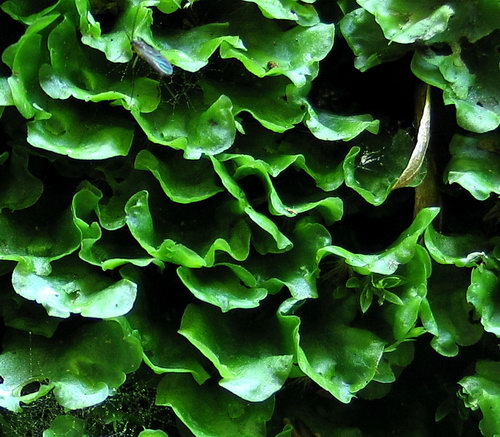
1 Upper surface of thallus with diamond-shaped markings, in the centre of each diamond-shaped area a more or less raised pore — 2
Upper surface of thallus without such markings and pores — 4
2 Gemmae present in goblet-shaped receptacles — Marchantia polymorpha (gemmae, female sporangia)
Gemmae present in crescent-shaped, ledge-like receptacles — Lunularia cruciata
Gemmae absent — 3
3 Pores on dorsal surface of thallus easily visible to naked eye; thallus not purple-brown at margin, ventral scales not over- lapping one another — Conocephalum conicum
Pores on dorsal surface hardly visible to naked eye; thallus purple-brown at margin, ventral scales overlapping one another — Preissia quadrata
4 Plants growing in pale green rosettes on arable land, etc. Thallus branches with pronounced median grooves — Riccia spp.
Plants deep or vivid green; habit various; .thallus branches without pronounced median grooves — 5
5 Thallus less than 2 mm. broad 6 Thallus 3-10 rom. broad (even broader at times in Anthoceros) — 7
6 Midrib present and well defined; chiefly on trees — Metzgeria furcata
Midrib lacking or at most ill defined; in marshes, etc. (never on trees) — Riccardia spp.
7 Midrib well defined, obvious in ventral view or transverse section — Pellia spp. (P. epiphylla by far the commonest, also Pellia endivifolia)
Midrib not well defined — 8
8 Thallus broad (up to 1-3 cm. at times), texture thin and delicate; plant forming dark green rosettes; capsule long and narrow (up to 3-5 cm.), 2-valved — Anthoceros spp.
Thallus
narrow
(not more than 6-8 mm. wide), thick and brittle in texture; not
forming rosettes; capsule ovoid, 4-valved — Riccardia
pinguis

This section of the key has been little altered in respect to the orginal key by Watson.
 |
For comments about this site
please mail to:
 (e-mail address given as graphic to avoid spam) |